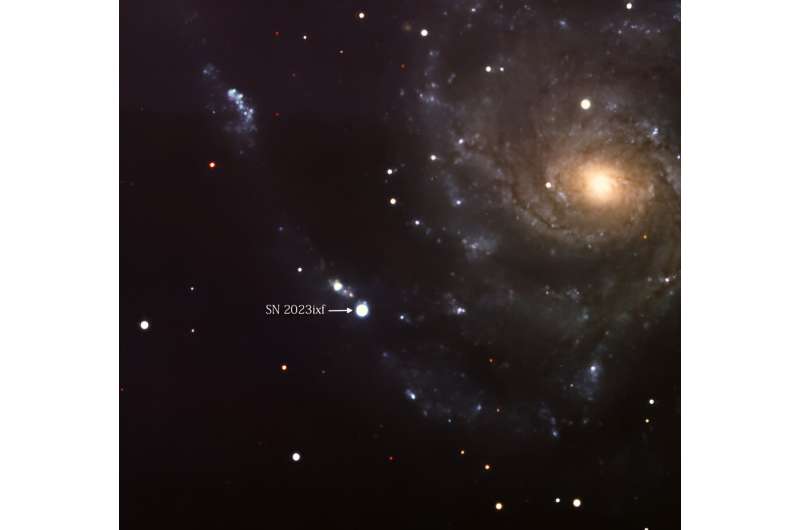Study reveals violent material ejection process of a dying massive star

A research team led by Dr. Zhang Jujia from Yunnan Observatories of the Chinese Academy of Sciences and Prof. Wang Xiaofeng from Tsinghua University has revealed the stellar mass violently ejected from a progenitor at the end of its life by observing the once-in-a-decade supernova SN 2023ixf. Such mass loss processes can provide essential information for understanding the final evolution of a massive star.
was published in Science Bulletin on Sept. 14.
Type II supernovae (SNe II) are the most common stellar explosions in the universe, for which the final stage of evolution of their hydrogen-rich massive progenitors towards core-collapse explosion is elusive. The final stage evolution and the resultant circumstellar environments have led to a rich diversity of such explosions.
To establish a link between the explosion of SNe II and the late-time evolution of massive stars, it is necessary to capture the first-light signals of the SN explosions, i.e., the flashed spectra, due to the ionization of the circumstellar material (CSM)/stellar wind by ultraviolet/high energy photons from shock breakout cooling.
The recent explosion of SN 2023ixf in a very nearby galaxy, Messier 101, provides a rare opportunity to address this long-standing issue. Timely, high-cadence flash spectra taken within one to five days of the explosion allow researchers to place stringent constraints on the properties of the surrounding circumstellar material surrounding this supernova.
It is estimated that the progenitor of SN 2023ixf lost material at a mass-loss rate of 6 × 10-4 M⊙ yr-1 during the last two to three years before the explosion. The nearby material, moving at a velocity of 55 km s-1, accumulated a compact CSM shell within a radius of less than 7 × 1014 cm from the progenitor.
Considering the high mass-loss rate and relatively high wind velocity, together with the pre-explosion observations made about two decades ago, the progenitor of SN 2023ixf could be a short-lived yellow hypergiant that evolved from a red supergiant shortly before the explosion.
"The observation and investigation of SN 2023ixf is ongoing. A series of works on this SN will make it a milestone in the history of SNe II and will then help to reveal the fate of massive stars in the mass range from 10 to 20 M⊙," said Dr. Zhang.
More information: Jujia Zhang et al, Circumstellar material ejected violently by a massive star immediately before its death, Science Bulletin (2023).
Provided by Chinese Academy of Sciences





















